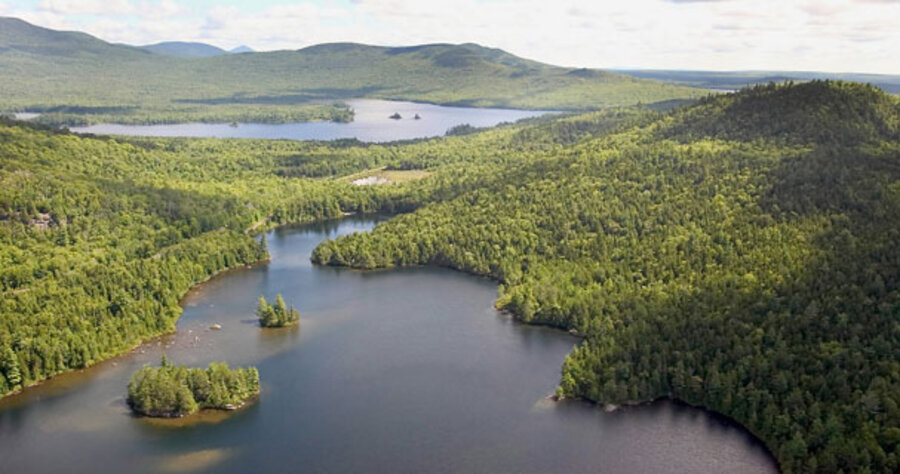New test for developers in Maine: climate change
Loading...
A plan to build thousands of new homes next to a lake in Maine's north woods faces an environmental test that may one day challenge developers nationwide: What's the carbon footprint of a new subdivision or land development?
At hearings last month, Maine environmentalists unveiled for state regulators what is being called a first-in-the-nation study of the greenhouse-gas emissions expected from a huge development planned for Maine's Moosehead Lake. Some observers call it a new front in an emerging battle between environmentalists and developers that started in California two years ago.
"What we're asking in the [Maine] case, for the first time, is to consider the net carbon impacts of a major proposed development," says Michael Stoddard, deputy director of Environment Northeast, the Boston environmental research group that did the study.
So how much carbon does a development emit? Environment Northeast estimates that the plan to clear 14,000 acres of forest to build about 2,300 apartment units and homes could generate up to 500,000 metric tons of carbon-dioxide emissions over 50 years, if emissions of vehicles traveling to the distant site are included. The US emits some 12,000 times that amount in a single year.
The developer, Plum Creek Timber Co., disputes the analysis.
"Our plan in Maine is very sensitive to the carbon-footprint issue," says Kathy Budinick, spokeswoman for Seattle-based Plum Creek. "If our plan is approved, more than 400,000 acres of land will be permanently conserved in perpetuity for sustainable forestry, representing the second-largest conservation easement in US history. It's really quite a phenomenal carbon outcome."
At issue is not just the size of a development but the amount of driving it encourages. By being so far from major cities and accessible only by car, the Plum Creek project would produce, conservatively speaking, an additional 9,500 tons of emissions annually, according to the Environment Northeast study. That's the equivalent of putting an extra 1,850 vehicles on the road.
"It's our belief that we can't meet the nation's transportation goals for climate change just by improving automobile technology," says Alan Caron, president of GrowSmart Maine, an antisprawl group that lobbies for compact urban planning and public transportation systems and helped sponsor the Plum Creek study. "You have to pay attention to where things are located."
States eye impact of developments
Other states are beginning to scrutinize the climate impact of real estate developments.
At least 35 states have climate-action plans or are in the process of developing them, says Reid Ewing, executive director of the National Center for Smart Growth Research and Education at the University of Maryland. Of those, 17 states have set emissions targets for greenhouse gases.
But laws that allow direct action are still limited. Only California, Massachusetts, and King County, Wash., have specifically incorporated climate-change analysis into the state environmental-review process as it applies to land development, experts say.
"It's mostly talk in the other states," Dr. Ewing says. "But that's only because at this point nobody is exactly sure how to get there. A lot of people are talking about it and many are following California's lead."
California's attorney general has also been a driving force in challenging development because of its climate effects. Last April, he sued San Bernardino County, claiming its development plan didn't go far enough in evaluating greenhouse-gas emissions as required by the California Environmental Quality Act. The attorney general also sued ConocoPhillips over a refinery expansion plan in Contra Costa County. Both cases saw settlements last year that require action to take greenhouse-gas emissions into account.
Liability-conscious California cities and towns are now rushing to include basic greenhouse-gas assessments in their development plans, experts say. At least 148 land-development filings under the environmental quality act last year cited greenhouse-gas emissions as a key issue – compared with just two known cases a year earlier.
"We've seen a substantial increase over years past," says Scott Morgan, senior planner with the California Governor's Office of Planning and Research. "Climate change has kind of permeated everything with regard to land use."
A major challenge for California cities, counties, and developers is the lack of specific threshold standards for greenhouse-gas emissions, he adds. But his office expects to develop such standards by 2010.
Environmental groups, meanwhile, are stepping up their legal challenges to new land developments.
In 2006, the Center for Biological Diversity, which specializes in legal action to protect endangered species, sued Banning, Calif., a city of about 30,000, for its alleged failure to evaluate the impact on climate of a proposed development of about 1,500 homes.
"We wanted them to take their carbon footprint into account and really look at the greenhouse-gas issue," says Matt Vespa, an attorney with the center. "They just ignored us."
Officials for the city say they hope the case, which is awaiting a judge's verdict, will validate the city's earlier environmental impact assessment of the development.
"Banning is very concerned about being a green city and being protective of the environment," says Julie Hayward Biggs, Banning's city attorney. "There was no requirement to take greenhouse emissions into account at the time the city approved the development – and there still are no standards."
Plum Creek decision this summer?
Meanwhile, the last hearings on Maine's Plum Creek project are scheduled for this week.
State officials are expected to rule as soon as this summer on the company's request to rezone hundreds of thousands of acres for development.
"Climate change will be the defining issue for urban planning and land development in the years ahead," says Ewing. "It will trump everything."





